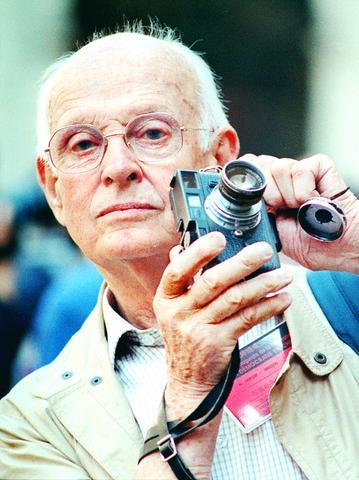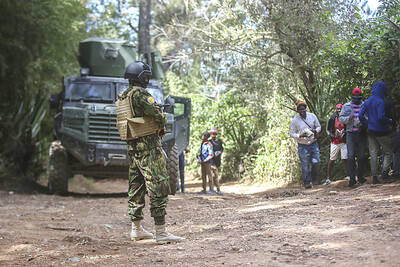Legendary photographer Henri Cartier-Bresson, who traveled the world for more than a half-century capturing human drama with his camera, has died, the French Cul-ture Ministry said. He was 95.
Cartier-Bresson shot for Life, Vogue and Harper's Bazaar and his work inspired generations of photographers. Cartier-Bresson became a French national treasure, though he was famously averse to having his own picture taken or to giving interviews.

PHOTO: REUTERS
A statement from his family and the Magnum photo agency, which Cartier-Bresson co-founded, said he died on Tuesday and a private funeral was held on Wednesday.
Paul Bruton, a Magnum spokes-man, said he had died at home in Cereste in southeastern France, and was buried in the nearby Alpes-de-Haute-Provence region.
French President Jacques Chirac said: "With him, France loses a genius photographer, a true master and one of the most gifted artists of his generation and most respected in the world."
Whether recording the funeral of Mahatma Gandhi in India or Henri Matisse at home, Cartier-Bresson sought to render the feeling of the moment with his distinctive classical style and penchant for geometrical composition.
"In whatever one does, there must be a relationship between the eye and the heart," he once said in a rare interview. "With the one eye that is closed, one looks within; with the other eye that is open, one looks without."
His photography centered on what he described as "the decisive moment" evoking the significance of a given situation as all the external elements fall into place.
Cartier-Bresson worked only with black-and-white film and without a flash. Thrusting a subject in the limelight, he once said, was a sure way to destroy it.
While most of his international fame was generated from worldwide exhibitions and publications, Cartier-Bresson gained recognition from two documentary films he made, one about medical aid to the loyalists in the Spanish Civil War and the other about French prisoners of war returning home at the end of World War II.
Cartier-Bresson was born Aug. 22, 1908, in Chanteloup outside Paris to a wealthy textile family. At 20, he turned his back on the family business to study painting. He had his first exhibitions in Madrid and New York in 1933.
At the outbreak of World War II, he was drafted into the French army, where he was captured in June 1940. After nearly three years in German prison camps, Cartier-Bresson escaped and returned to Paris, where he transported ex-prisoners for the underground.
In the last 25 years of his life, Cartier-Bresson largely turned away from photography to embrace his first love, painting.

A fire caused by a burst gas pipe yesterday spread to several homes and sent a fireball soaring into the sky outside Malaysia’s largest city, injuring more than 100 people. The towering inferno near a gas station in Putra Heights outside Kuala Lumpur was visible for kilometers and lasted for several hours. It happened during a public holiday as Muslims, who are the majority in Malaysia, celebrate the second day of Eid al-Fitr. National oil company Petronas said the fire started at one of its gas pipelines at 8:10am and the affected pipeline was later isolated. Disaster management officials said shutting the

DITCH TACTICS: Kenyan officers were on their way to rescue Haitian police stuck in a ditch suspected to have been deliberately dug by Haitian gang members A Kenyan policeman deployed in Haiti has gone missing after violent gangs attacked a group of officers on a rescue mission, a UN-backed multinational security mission said in a statement yesterday. The Kenyan officers on Tuesday were on their way to rescue Haitian police stuck in a ditch “suspected to have been deliberately dug by gangs,” the statement said, adding that “specialized teams have been deployed” to search for the missing officer. Local media outlets in Haiti reported that the officer had been killed and videos of a lifeless man clothed in Kenyan uniform were shared on social media. Gang violence has left

US Vice President J.D. Vance on Friday accused Denmark of not having done enough to protect Greenland, when he visited the strategically placed and resource-rich Danish territory coveted by US President Donald Trump. Vance made his comment during a trip to the Pituffik Space Base in northwestern Greenland, a visit viewed by Copenhagen and Nuuk as a provocation. “Our message to Denmark is very simple: You have not done a good job by the people of Greenland,” Vance told a news conference. “You have under-invested in the people of Greenland, and you have under-invested in the security architecture of this

Japan unveiled a plan on Thursday to evacuate around 120,000 residents and tourists from its southern islets near Taiwan within six days in the event of an “emergency”. The plan was put together as “the security situation surrounding our nation grows severe” and with an “emergency” in mind, the government’s crisis management office said. Exactly what that emergency might be was left unspecified in the plan but it envisages the evacuation of around 120,000 people in five Japanese islets close to Taiwan. China claims Taiwan as part of its territory and has stepped up military pressure in recent years, including